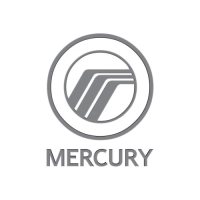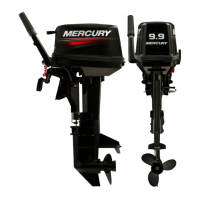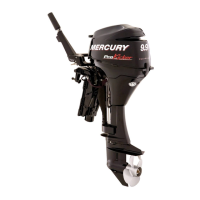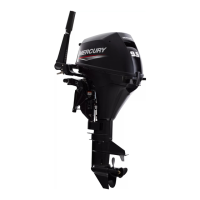Do you have a question about the Mercury 9.9 ProKicker and is the answer not in the manual?
Lists engine models, starting serial numbers, and certificate numbers.
Lists essential requirements for noise emissions.
Details on how to register the product for warranty coverage.
Explains the process for transferring the limited warranty to a new owner.
Outlines the transferability of the extended service coverage plan.
Details the limited warranty for FourStroke outboard engines in the US & Canada.
Specifies the duration of warranty coverage for recreational and commercial use.
Lists requirements for obtaining warranty coverage, including dealer purchase and maintenance.
Outlines Mercury's obligations for warranty repairs or replacements.
Explains the process for submitting warranty claims and obtaining service.
Lists exclusions from the limited warranty, including routine maintenance and damage.
Details disclaimers on implied warranties and limitations on damages.
Outlines warranty for Europe and Confederation of Independent States.
Specifies warranty duration for recreational and commercial use outside US/Canada.
Lists requirements for warranty coverage, including dealer purchase and maintenance.
Explains Mercury's warranty obligations for repairs or replacements.
Details the process for warranty claims and obtaining service.
Lists warranty exclusions, like maintenance, abuse, and improper installation.
Details disclaimers on implied warranties and limitations on damages.
Outlines warranty for Middle-East and Africa markets.
Specifies warranty duration for recreational and commercial use in MEA region.
Lists requirements for warranty coverage, including dealer purchase and maintenance.
Explains how to get warranty service for California emission systems.
Lists exclusions from the California emission warranty.
Details disclaimers on implied warranties and limitations on damages.
Covers warranty against corrosion for three years from sale or first use.
Outlines Mercury's obligations for corrosion warranty repairs or replacements.
Explains the process for submitting corrosion warranty claims.
Details disclaimers on implied warranties and limitations on damages.
Explains what is covered and excluded by the warranty.
Lists specific exclusions from warranty coverage, such as minor adjustments and tune-ups.
Details the 5-year/175-hour warranty for emission control systems.
Lists components covered under the EPA emission-related warranty.
Explains the warranty for emission control systems in California.
Specifies what Mercury warrants for California emission control systems.
Details the duration of the California emission warranty (4 years or 250 hours).
Explains how to get warranty service for California emission systems.
Lists exclusions from the California emission warranty.
Details disclaimers on implied warranties and limitations on damages.
Explains California emission warranty rights and responsibilities for owners.
Explains the meaning of different star labels indicating emission levels.
Outlines the operator's duties for safe boat operation.
Advises reading the manual carefully before operating the outboard.
Warns against exceeding the boat's maximum horsepower rating.
Describes the requirement for a start-in-neutral protection device on remote controls.
Emphasizes using self-locking nuts for steering link rod attachment.
Explains the function of the lanyard stop switch for engine shutdown.
Describes the lanyard cord length and its purpose.
Highlights safety aspects of lanyard stop switch operation and potential hazards.
Instructs on checking the proper operation and condition of the lanyard stop switch.
Provides safety advice for preventing injury to swimmers near the boat.
Offers safety advice for passengers on pontoon and deck boats.
Discusses hazards associated with wave and wake jumping.
Advises reducing speed and exercising caution in areas with underwater obstacles.
Provides specific safety guidelines for hand-tilled outboards.
Warns about carbon monoxide poisoning from engine exhaust.
Discusses ventilation to prevent carbon monoxide buildup in boats.
Recommends using genuine Mercury accessories and checking compatibility.
Offers suggestions for safe boating practices and regulations.
Stresses the importance of recording the outboard's serial number for reference.
Provides technical specifications for 8/9.9 FourStroke models.
Lists detailed engine specifications like bore, stroke, and oil capacity.
Identifies key components of standard model outboards with a diagram.
Identifies front-facing components of the outboard with labels.
Identifies components visible from the port side of the outboard.
Identifies components specific to BigFoot/ProKicker models.
Identifies additional components like power tilt and kicker strap.
Provides procedures for safe transport and storage of removed outboards.
Offers safety warnings and instructions for transporting fuel tanks.
Explains manual and auto-venting fuel tank features and operation.
Instructs on trailering boats with power tilt outboards.
Provides instructions for trailering boats with non-power tilt outboards.
Details recommended gasoline octane ratings and types for Mercury engines.
Explains adverse effects of alcohol in gasoline and storage recommendations.
States EPA requirement for low permeation fuel hoses on outboards.
Outlines EPA requirements for pressurized portable fuel systems.
Explains the need for a fuel demand valve with pressurized tanks.
Describes features of Mercury's portable pressurized fuel tanks.
Provides steps for safely removing the fuel cap from pressurized tanks.
Gives instructions for operating and securing pressurized fuel tanks.
Offers safety precautions for filling fuel tanks.
Recommends specific Mercury/Quicksilver NMMA FC-W certified oils.
Details the procedure for checking and inspecting engine oil levels.
Describes features of the tiller handle, including tilt and lock.
Explains tiller handle lock cap and starter rope operation.
Refers to General Information for lanyard stop switch details.
Describes the engine stop switch and power tilt function.
Explains how to adjust the throttle grip friction for speed control.
Details the throttle only button and throttle grip functions.
Explains the use of the choke and fuel primer for starting.
Describes the function of the low oil pressure warning light.
Explains the operation of the electric start button.
Instructs on adjusting steering friction for desired drag.
Explains the function of the tilt lock knob.
Describes the trim position knob for setting trim.
Explains the purpose of the kicker strap on power tilt models.
Identifies and describes various controls on Mercury/Quicksilver remote control units.
Details the engine's warning system, including oil pressure light.
Explains the function and operation of the power tilt system.
Provides step-by-step instructions for tilting the outboard.
Explains how to adjust the transom angle for optimal performance.
Illustrates and describes effects of different outboard trim angles.
Provides steps for adjusting the transom angle using the preset tilt knob.
Explains how to use shallow water drive positions for operation.
Details the procedure for manually tilting the outboard to various positions.
Explains how to adjust the trim tab to reduce steering torque.
Lists essential checks to perform before starting the outboard.
Provides precautions for operating the outboard in freezing conditions.
Advises flushing and cleaning the outboard after use in saltwater.
Details the initial steps for starting the engine.
Outlines the recommended procedure for breaking in a new engine.
Provides step-by-step guide for starting tiller handle models.
Details specific steps for starting cold and warm tiller handle models.
Explains manual starting rope and electric start button procedures.
Guides on how to start a flooded engine.
Provides step-by-step guide for starting remote control models.
Details specific steps for starting cold and warm remote control models.
Explains the procedure for starting a hot engine.
Describes how to shift gears for tiller handle and remote control models.
Provides instructions for stopping the engine on remote control and tiller handle models.
Guides on how to start the engine using the emergency starter rope.
Details steps for emergency starting, including flywheel cover removal.
Emphasizes periodic inspections and maintenance for optimal condition.
Recommends using genuine Mercury Precision or Quicksilver parts.
Discusses compliance with EPA air pollution control regulations for new outboards.
Explains the purpose and content of the emission certification label.
Outlines owner's duty to maintain emission levels and not modify engine.
Lists daily checks for oil level and lanyard stop switch function.
Lists checks for fuel system, transom tightness, steering, and propeller.
Details lubrication, oil changes, spark plug replacement, and thermostat inspection.
Specifies replacing the water pump impeller at 300 hours or three years.
Explains how to flush cooling system with fresh water.
Details steps for flushing the outboard's cooling system using a flushing device.
Outlines connecting hose, starting engine, and monitoring water flow during flushing.
Provides instructions for removing and reinstalling the outboard's top cowl.
Advises on inspecting the battery for security and terminal cleanliness.
Recommends cleaning and waxing the outboard's exterior finish.
Warns about flammable fuel and provides safety steps for servicing the fuel system.
Instructs on inspecting and replacing the fuel line filter if contaminated.
Emphasizes using specific hardware and never replacing locknuts with common nuts.
Provides torque specifications for steering link rod fasteners.
Advises periodic inspection and replacement of the corrosion control anode.
Warns about propeller hazards and provides initial steps for replacement.
Details steps for removing the propeller, including using lubricant.
Recommends lubricating the propeller shaft to prevent corrosion.
Explains how to replace fuses in electric start models.
Details how to identify and replace a blown fuse.
Warns about spark plug boot damage and guides on inspection and replacement.
Guides on inspecting spark plugs, setting gap, and installation torque.
Explains conditions requiring timing belt inspection and replacement.
Lists specific conditions indicating timing belt wear or damage.
Details the procedure for changing engine oil.
Provides instructions for refilling engine oil, emphasizing not to overfill.
Lists lubrication points and recommended lubricants.
Identifies specific lubrication fittings on the swivel bracket, transom, and tilt tube.
Explains lubrication for throttle/shift cables and steering cable fittings.
Guides on lubricating steering link rod pivot points with lightweight oil.
Recommends lubricating the propeller shaft to prevent corrosion.
Advises checking gearcase lubricant for water and inspecting for metal particles.
Provides steps for draining the gearcase lubricant.
Lists gearcase capacities and recommended lubricant types.
Details the procedure for checking and refilling gearcase lubricant.
Explains how to check and top off power tilt fluid.
Stresses the need for prompt service by a dealer for submerged outboards.
Outlines procedures for preparing the outboard for storage.
Advises lubricating external parts and touching up paint nicks.
Details steps for protecting internal engine parts, including oiling cylinders.
Instructs to drain and refill gearcase lubricant for storage.
Specifies correct positions for storing the outboard to prevent damage.
Provides instructions for storing the battery properly.
Lists possible causes for the engine failing to start.
Lists possible causes for reduced engine performance.
Outlines steps for obtaining assistance if dealership cannot resolve issues.
Provides contact information for Mercury Marine service offices worldwide.
Warns against exceeding the boat's maximum horsepower rating.
Warns about proper installation of the outboard using required hardware.
Guides on centering and tightening the outboard on the transom.
Details bolt requirements and torque for non-power tilt models.
Details bolt requirements and torque for power tilt models.
Guides on lubricating and installing the steering cable.
Details steps for removing covers and connecting the remote wiring harness.
Details steps for installing the throttle cable to the remote control.
Guides on installing the shift cable, locating slack points.
Provides instructions for mounting and connecting the battery for electric start.
Warns about propeller hazards and guides on lubricating and installing the propeller.
| Brand | Mercury |
|---|---|
| Model | 9.9 ProKicker |
| Category | Outboard Motor |
| Language | English |












